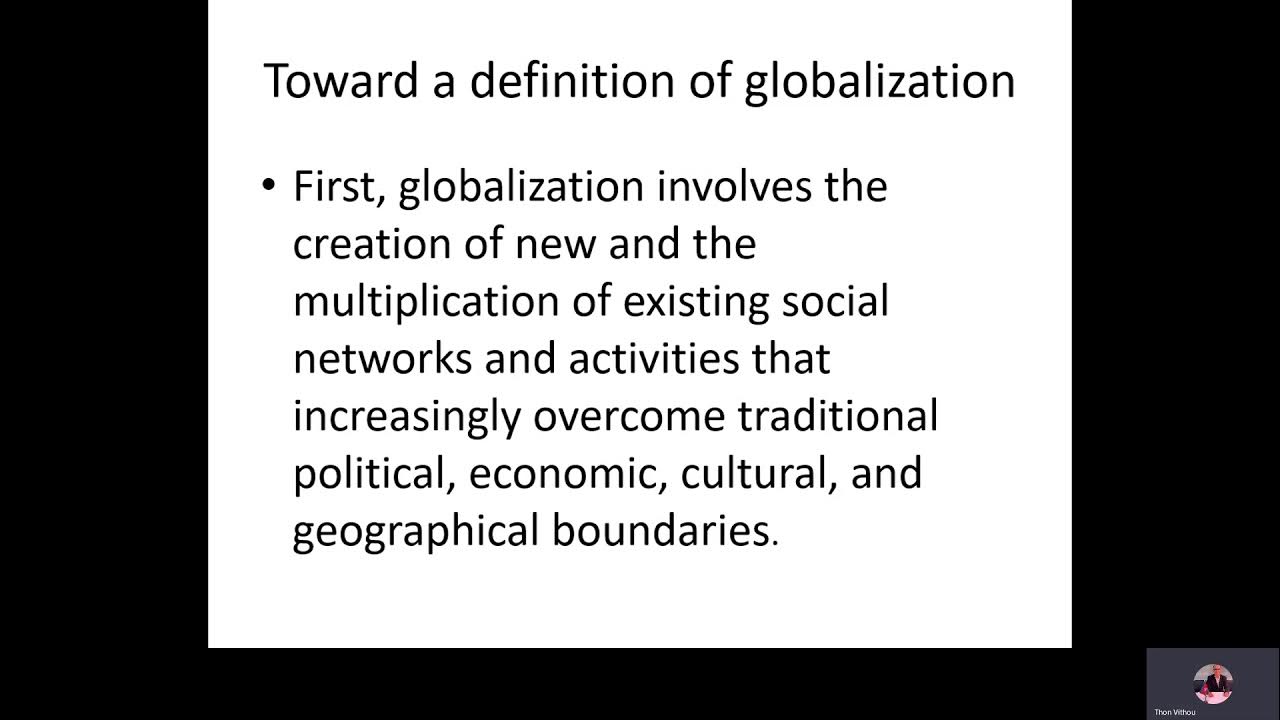CHAPTER 4: ASIAN REGIONALISM || The Contemporary World - Marvin Cabañero
Summary
TLDRThis lecture explores Asian regionalism, distinguishing it from globalization and regionalization. It emphasizes economic interactions over political planning, leading to increased integration among Asian countries. The lecture highlights the role of ASEAN in fostering cooperation and the challenges faced, such as the 1997 financial crisis. It also discusses the impact of regional integration on trade, cultural exchange, and shared interests in the region.
Takeaways
- 🌐 **Regionalism Defined**: Regionalism is a political ideology favoring a specific region over a larger area, often due to political, religious, geographical, cultural, linguistic, or administrative divisions.
- 🌍 **Regionalization vs. Globalization**: Regionalization is the division of an area into smaller regions, while globalization is the unification of the world into a single society.
- 🏦 **Economic Focus of Asian Regionalism**: Asian regionalism arises from economic interactions rather than political planning, aiming to enhance regional integration through economic cooperation.
- 🌟 **Unity in Diversity**: Asia is considered a continent of diversity with different cultures, customs, religions, and governments, yet it seeks unity through economic cooperation.
- 📈 **Economic Growth and Integration**: Asian economies have grown richer and more interconnected through trade, financial flows, direct investments, and social exchanges.
- 💼 **ASEAN as an Example**: The Association of Southeast Asian Nations (ASEAN) is a prime example of unity in diversity, promoting economic, political, and security cooperation among its members.
- 📉 **Challenges Faced**: Asia has faced challenges such as the 1997 financial crisis, which highlighted the need for regional cooperation and integration.
- 🚀 **Economic Development and Interdependence**: Asian economies have become intertwined due to their growing size and the dependency on production networks spanning multiple economies.
- 🌱 **Non-discriminatory and Outward-Oriented**: Despite interdependence, Asian economies remain non-discriminatory and outward-oriented in their development strategies.
- 🔄 **Intra-regional Trade**: There has been an increase in trade and commodity exchange between countries within the same region, leading to reduced inflation and tariff barriers.
Q & A
What is the main focus of the lecture?
-The main focus of the lecture is Asian regionalism, specifically discussing the economic interaction between Asian countries and how it has led to regional integration.
What is regionalism?
-Regionalism is a political ideology that favors a specific region over a greater area, often due to political, religious, geographical, cultural, linguistic, or administrative divisions. It involves economic operations and arrangements among a group of countries aimed at enhancing regional integration.
How does regionalization differ from globalization?
-Regionalization is the process of dividing an area into smaller segments called regions, whereas globalization is the process by which people of the world are unified into a single society, functioning together with interconnectedness and interrelation.
Why do countries form regional organizations?
-Countries form regional organizations as a way of coping with the challenges of globalization, to enhance cooperation, and to address shared interests and vulnerabilities within a region.
What is the role of ASEAN in Asian regionalism?
-ASEAN, or the Association of Southeast Asian Nations, plays a significant role in Asian regionalism by promoting economic, political, and security cooperation among its 10 member countries.
What is the significance of the 1997-1998 financial crisis in the context of Asian regionalism?
-The 1997-1998 financial crisis was a severe setback for the region, highlighting Asia's shared interests and vulnerabilities, and providing an impetus for increased regional cooperation.
How has the economic growth of Asian countries contributed to regionalism?
-The economic growth of Asian countries has led to increased interdependence and integration through trade, financial flows, direct investments, and other forms of economic and social exchange.
What is the concept of 'flying geese' in the context of Asian economic development?
-The 'flying geese' model, as described by Japanese economist Akamatsu in 1962, refers to the pattern of development where Asian economies follow similar paths of growth, initially focusing on exporting labor-intensive manufactures, and not directly linked to each other but moving in a sequential manner.
How does regional integration contribute to peace and stability?
-Regional integration contributes to peace and stability by promoting cooperation among neighboring states through common institutions and rules, reducing the possibility of regional armed conflict, and adopting cohesive regional policies on issues such as the environment and migration.
What is intra-regional trade and how does it benefit a region?
-Intra-regional trade refers to economic exchanges primarily between countries of the same region or economic zone. It benefits a region by increasing the level of trade and commodity exchange, reducing inflation and tariff barriers, and leading to growing prosperity.
What are the objectives of regional integration?
-The objectives of regional integration include upgrading cooperation through common institutions and rules, achieving peace, stability, and wealth, and focusing on commercial interests to achieve broader social, political, and security objectives.
Outlines

Dieser Bereich ist nur für Premium-Benutzer verfügbar. Bitte führen Sie ein Upgrade durch, um auf diesen Abschnitt zuzugreifen.
Upgrade durchführenMindmap

Dieser Bereich ist nur für Premium-Benutzer verfügbar. Bitte führen Sie ein Upgrade durch, um auf diesen Abschnitt zuzugreifen.
Upgrade durchführenKeywords

Dieser Bereich ist nur für Premium-Benutzer verfügbar. Bitte führen Sie ein Upgrade durch, um auf diesen Abschnitt zuzugreifen.
Upgrade durchführenHighlights

Dieser Bereich ist nur für Premium-Benutzer verfügbar. Bitte führen Sie ein Upgrade durch, um auf diesen Abschnitt zuzugreifen.
Upgrade durchführenTranscripts

Dieser Bereich ist nur für Premium-Benutzer verfügbar. Bitte führen Sie ein Upgrade durch, um auf diesen Abschnitt zuzugreifen.
Upgrade durchführen5.0 / 5 (0 votes)






